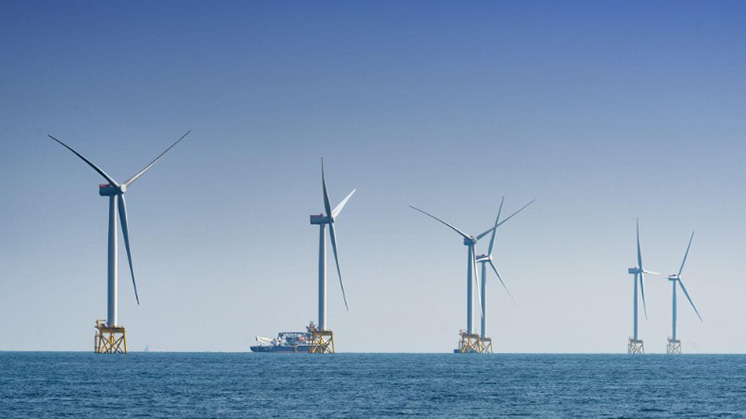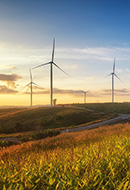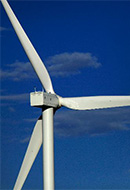The visual impact of offshore wind energy
The visual impact of offshore wind: how to integrate wind turbines into the coastal landscape
Through rigorous environmental impact studies and careful planning, Iberdrola seeks ways to minimise the visual impact that wind turbines at offshore wind farms can have in the areas where they are built.

In recent decades, offshore wind has experienced tremendous growth globally in response to the need for more environmentally friendly energy sources. According to 2022 data from the Global Wind Energy Council (GWEC), nearly 64 GW of offshore wind capacity has already been installed worldwide, representing an increase of more than 77% in just two years since 2020.
However, as more and more countries begin large-scale deployment of offshore wind energy, we should keep a close eye on one of the biggest challenges in relation to this type of renewable technology: the visual impact that these installations can have on the coastal landscape.
When we talk about the visual impact of an offshore wind farm, we’re referring to the visualisation of all the elements that make up this large electrical infrastructure, as well as how they can change the aesthetics of the landscape of a natural coastal environment. This includes the changes caused by the presence of wind turbines, offshore and onshore substations, operating platforms or cables in the coastal area.
The main factor that means a wind installation makes more or less of a visual impact on an environment is obviously the distance of the turbines from the coast. But that’s not the only factor. In the case of wind turbines, the height and diameter of the rotor also has a direct influence on their visibility: the larger they are, the further they have to be from land to be invisible.
There is also an impact on the landscape at night. Every turbine in a wind farm must be equipped with independently illuminated signage so that they are visible to other naval users as well as aircraft. This signage can alter the appearance of the landscape at night.
For this reason, several lines of research have been followed for some time now to assess the visual impact of offshore wind on the oceans and coastlines. Through technical and innovative solutions, these studies aim to find ways of installing an offshore wind farm to add value to the landscape, contributing to the region’s identity and development.

Wind measurement for wind farm
We tell you about the latest technological developments in this area.

The most relevant terms in offhore wind energy
We propose some relevant terms to understand how wind energy works.

What is the most efficient place to install a turbine?
Find out where wind turbines are placed to make the most of the wind.
How is the visual impact of an offshore wind farm assessed?
Before starting to build offshore wind turbines, a series of environmental studies must be done. As these are constructions involving highly complex engineering works on the high seas, the projects need to have an official document called an Environmental Impact Statement (EIS), which is incorporated into the regulations of the countries' environmental bodies.
This study explains the compatibility of the park with other uses of the maritime space, such as fishing or navigation, marine fauna, birdlife, migration routes and sediment transport. In addition to analysing purely technical aspects such as the type of foundations used in the installation, these reports aim to describe in detail how the project will impact the local marine habitat, whether it will affect air and water quality, the possible noise it may generate and its impact on the natural resources of the oceans, such as mineral salts.
This type of study is also concerned with analysing the visual impact that offshore wind farms can have on coastal environments. It seeks to understand how wind turbines and other offshore wind elements change the appearance of the site’s landscape to propose countermeasures to minimise them.
Below, we’ll review the main measures proposed by the different reports already published to minimise the visual effects that an offshore wind farm might have:
 Distance from the coast
Distance from the coast
Installing wind farms at a distance from the coast, where they are less visible from land, is the main measure to reduce their visual impact. According to a UK study by researchers at the Argonne National Laboratory, small to moderate-sized installations are ‘a major focus of visual attention’ at distances of up to 16 kilometres. In the case of wind farms at distances of almost 29 kilometres, they are ‘no longer perceived by a casual observer’, while at distances greater than 40 kilometres, they are only visible ‘with magnified vision’.
However, studies suggest that, under certain atmospheric conditions and lighting angles, casual observers can perceive wind installations at distances of more than 35 kilometres. The published report also points out that it should be noted that objects on the horizon can be seen at greater distances from elevated vantage points due to the masking effect of the earth's curvature.
 Integrated design
Integrated design
Another measure is to plan the design of wind farms so that they blend in with the natural environment. In many cases, wind turbines or substations are made in colours and shapes that are in harmony with the seascape. In addition, reforestation is used near onshore elements, such as onshore power substations or operation and maintenance buildings.
The visual impact of wind turbines on the coastal skyline
Distance from the coast and the visual perception of the towers

Up to 16 kilometres
They are an important focus of visual attention
Nearly 29 kilometres away
Not perceived by a casual observer
Over 40 kilometres
Only visible with magnified or focused vision
Factors affecting the visibility of wind turbines:
Distance from the shore
Viewing angle
Weather conditions
Intensity of sunlight
Contrast of turbines with sky and water
Height of towers and blades
Night beacon
Iberdrola's offshore wind farms and their distances from the coast:
-
United States
Vineyard Wind I: 24 km
Kitty Hawk: 44 km
-
United Kingdom
East Anglia ONE: 50 km
East Anglia TWO: 31 km
-
Germany
Baltic Eagle: 30 km
Wikinger: 75 km
-
France
Saint-Brieuc: 16.3 km
United States
Vineyard Wind I: 24 km
Kitty Hawk: 44 km
United Kingdom
East Anglia ONE: 50 km
East Anglia TWO: 31 km
Germany
Baltic Eagle: 30 km
Wikinger: 75 km
France
Saint-Brieuc: 16.3 km

Source: Argonne National Laboratory.
 SEE INFOGRAPHIC: The visual impact of wind turbines on the coastal skyline [PDF]
SEE INFOGRAPHIC: The visual impact of wind turbines on the coastal skyline [PDF]
 Orderly arrangement
Orderly arrangement
Consideration should be given to the organisation of turbines on an ocean surface, taking into account their arrangement and size in relation to the surrounding landscape. Following orderly and regular patterns reduces any chaotic visual effect and creates a more uniform appearance.
 Strategic location
Strategic location
When analysing potential locations for the wind farm, taking into account the proximity to residential areas or tourist spots where the wind turbines can be seen is key. In addition, all angles from which the turbines might be visible should be considered.
 Non-intrusive illumination
Non-intrusive illumination
It is equally important to take measures to minimise visual impact at night. Wind turbines at wind farms should follow the lighting standards of their country's aviation safety agencies, but with non-intrusive signage. The use of beacons emitting a steady red light, for example, is recommended.








